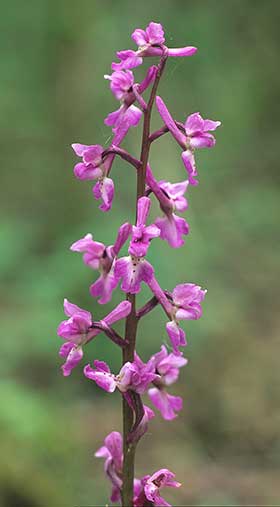Early purple orchid (Orchis mascula)
When: April - May
How many: Scarce in the New Forest

Early purple orchids get a head start to their annual cycle by taking nutrients stored in underground tubers. In fact, two tubers are present: one holds nutrients for current use, whilst the second fills ready for the following year.
Rich, centuries-old folk lore developed around these early purple orchid tubers. Similarity to testicles encouraged use as an aphrodisiac – they were dug up, dried and mixed with milk. The new, firm early purple orchid tuber that is filling for later use was said to excite desire, whilst the current year’s slack tuber would restrain it.
In Hamlet, Shakespeare referred to early purple orchids as ‘long purples’, and also said ‘but which cold maids do Dead Men’s Fingers call’, referring to another old country name.
The Hampshire name, adder’s flower, celebrates the appearance of early purple orchid blooms when the year’s first adders are abroad, and another Hampshire name, cuckoo flower, has similar derivation.
Early purple orchids are most at home in old woodlands and scrub, and flower from late-April, often as scattered blooms alongside or amongst, bluebells. They do, though, prefer neutral to calcareous soils, and are therefore only infrequently encountered in the New Forest’s typically acid soils.
Sadly, early purple orchids are also very susceptible to grazing pressure, so commoners’ stock, and deer often prevent growth even where the soils are suitable.
Stout early purple orchid stems rise to a height of 15-60 centimetres (6-24 inches), and support a loose, cylindrical spike of hooded flowers that are often a strikingly deep-purple colour, but with occasional pink and white variations. The lower petal forms a 3-lobed lip, providing a perfect landing place for visiting insects, whilst the nectar-holding spur has a blunt end, and is often upward curving.
The leaves vary from broad to narrow, but are always pointed, and often, but not always, have round, purple-black blotches. Early Purple Orchid aroma is said to be similar to that of tom cats.
References:
The Wild Flowers of Britain and Northern Europe: Richard Fitter, Alastair Fitter and Marjorie Blamey
The Flora of Hampshire: Anne Brewis, Paul Bowman and Francis Rose
Reader’s Digest Field Guide to the Wild Flowers of Britain
The Englishman’s Flora: Geoffrey Grigson
More links
Other related links
Search this site

Sadly, 58 animals were killed - 35 ponies, 13 cows, 8 donkeys and 2 sheep, whilst a further 32 were injured - 3 pigs, 9 donkeys, 11 cows and 9 ponies.
(Forty-three accidents occurred in daylight, 15 at twilight and 101 in the dark. Twenty-seven accidents were not reported by the driver involved).
Here's just one horrific example - Three donkeys killed in collision with van at notorious New Forest blackspot (Advertiser and Times)

